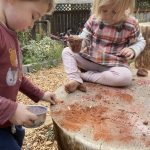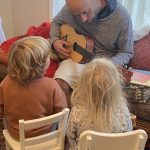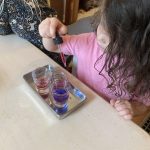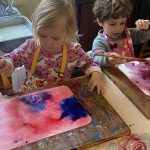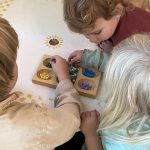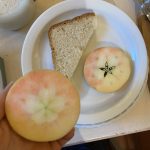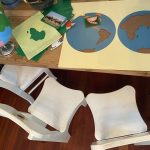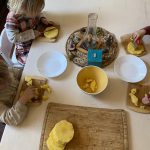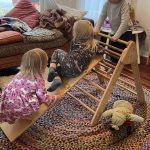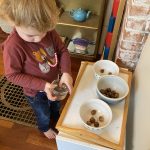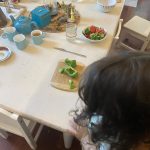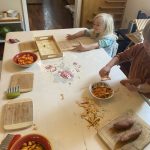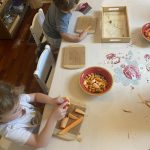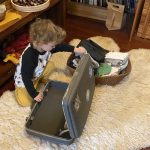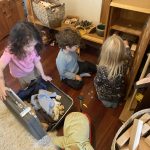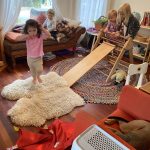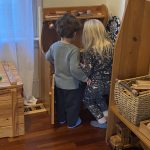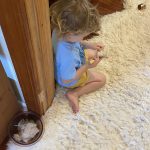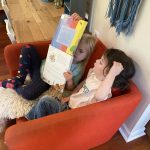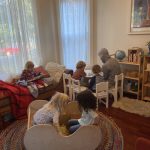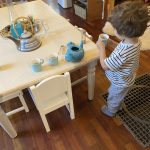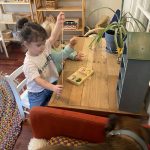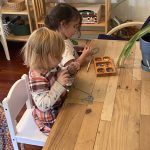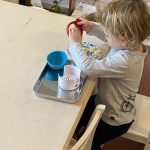Weekly Update: October 17-20
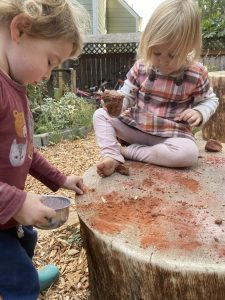 Despite being stuck inside for three days this week due to the smoke, our time together was not without its blessings! On Monday, before the smoke descended, everyone was engaged in crushing brick pieces into clay powder using the climbing stumps as work benches. Since there is only one outdoor mortar and pestle, I encouraged the children to find other tools with which to crush the brick: river rocks, a measuring cup, a larger brick piece. I often have to cheerily decline to help before children will search the yard for what they need. This is sometimes met with a blank stare at first, and it is very tempting to just hand them the perfectly shaped crushing rock that I noticed by the maple tree the day before, but then I remind myself that the internal request of the preschool-aged child (whether they know it or not) is “help me do it by myself.”
Despite being stuck inside for three days this week due to the smoke, our time together was not without its blessings! On Monday, before the smoke descended, everyone was engaged in crushing brick pieces into clay powder using the climbing stumps as work benches. Since there is only one outdoor mortar and pestle, I encouraged the children to find other tools with which to crush the brick: river rocks, a measuring cup, a larger brick piece. I often have to cheerily decline to help before children will search the yard for what they need. This is sometimes met with a blank stare at first, and it is very tempting to just hand them the perfectly shaped crushing rock that I noticed by the maple tree the day before, but then I remind myself that the internal request of the preschool-aged child (whether they know it or not) is “help me do it by myself.”
Being fully indoors the next three days was a challenge at times, but I also saw some developmental leaps forward in a couple of children, and plenty of good work took place. I brought out some indoor climbing equipment to help 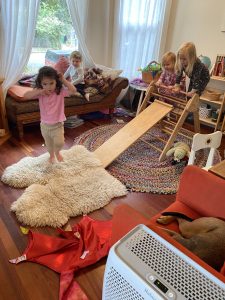 the children satisfy their need for gross motor movement: a Pikler triangle with a two-in-one slide and climbing ramp, and a rocking boat that can also be flipped over to make a climbing structure. The two can be combined as well, by using the ramp/slide to make a bridge between the Pikler triangle and the inverted boat. Lots of possibilities! We even used the triangle to create a tunnel leading into a table fort, by draping silks over it and holding them in place with play clips. The Pikler triangle was named after Emmi Pikler, who is known for her work in infant development, but this sturdy and versatile play equipment works really well for preschoolers too.
the children satisfy their need for gross motor movement: a Pikler triangle with a two-in-one slide and climbing ramp, and a rocking boat that can also be flipped over to make a climbing structure. The two can be combined as well, by using the ramp/slide to make a bridge between the Pikler triangle and the inverted boat. Lots of possibilities! We even used the triangle to create a tunnel leading into a table fort, by draping silks over it and holding them in place with play clips. The Pikler triangle was named after Emmi Pikler, who is known for her work in infant development, but this sturdy and versatile play equipment works really well for preschoolers too.
Some new works this week: air-dry modeling clay, wooden bead sorting (then a couple of days later, a more challenging sorting work with smaller beads made of polished stones), necklace making using the sorted beads (a pre-sewing work that uses embroidery needles), color mixing with an eyedropper, sink or float (a buoyancy exploration with acorns, which either sink or float depending on whether or not they are good to eat), and acorn cracking with mortar and pestle to remove the nut meat for processing.
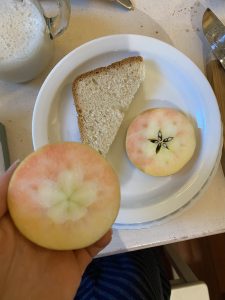 My favorite moment this week had to do with drawing a connection between our daily life and our October story: On Wednesday, Charlotte brought in a beautiful apple with rosy flesh to share with breakfast, and I sliced it open horizontally to reveal the “star of life” inside, the seeds arranged in a five-pointed pattern. We’ve done this a few times now, twice immediately after early performances of our puppet show, which is a “star in the apple” story about new life following decay. On Wednesday the effect was even more dramatic due to the pink-tinged flesh of the apple. “Look,” I said, “It’s the star of life in rosy clouds!” Then followed some group speculation about how the symbols of the October and September stories are connected, how the star of life is related to the castle of rosy clouds. “Maybe the star of life is inside the castle,” I mused, and then a child enthusiastically suggested, “Maybe the castle is inside the star of life.” I let that comment sit in appreciative silence, and it was a beautiful moment. I passed around the slices so that everyone could get a close look. The apple’s pinkness also emphasized a flower shape around the star (present in all apples, but not usually so visible), so we playfully talked about the “flower of life” as well.
My favorite moment this week had to do with drawing a connection between our daily life and our October story: On Wednesday, Charlotte brought in a beautiful apple with rosy flesh to share with breakfast, and I sliced it open horizontally to reveal the “star of life” inside, the seeds arranged in a five-pointed pattern. We’ve done this a few times now, twice immediately after early performances of our puppet show, which is a “star in the apple” story about new life following decay. On Wednesday the effect was even more dramatic due to the pink-tinged flesh of the apple. “Look,” I said, “It’s the star of life in rosy clouds!” Then followed some group speculation about how the symbols of the October and September stories are connected, how the star of life is related to the castle of rosy clouds. “Maybe the star of life is inside the castle,” I mused, and then a child enthusiastically suggested, “Maybe the castle is inside the star of life.” I let that comment sit in appreciative silence, and it was a beautiful moment. I passed around the slices so that everyone could get a close look. The apple’s pinkness also emphasized a flower shape around the star (present in all apples, but not usually so visible), so we playfully talked about the “flower of life” as well.
This interaction with the children felt like a spiritual conversation. I couldn’t articulate what exactly we were referring to, but I could feel it. It reminded me of the spiritual undertones of our morning candle-lighting ritual. We say, “Each 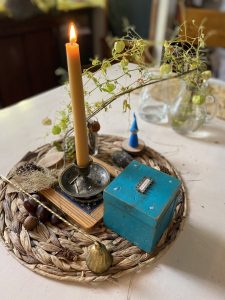 day the great sun shines brightly in us” and put our hands over our hearts, right after singing “This is a spark of the sun’s light” as I light the match and then the candle. Repeated for weeks on end, a semi-accidental profundity is creeping into this year’s morning symbols: a sun within us, a spark separating from the sun to light a candle that we are gathered around– a candle which is then snuffed as we go our separate ways into work and play, only to be re-lit the next time we gather. It seems to say something important about a shared origin, a shared essence, which we each possess individually and yet is perfectly singular: the great sun. It seems to speak of bringing the outer to the inner, the inner to the outer, and a pattern of union-separation-union-separation-union . . . Yet I could never explain or describe all this directly to children so young. I struggle to explain it at all, through these ideas are present in many religions. Visual symbols embedded in a story or poem, especially when enhanced with music, can hold so much more meaning and immediacy than a description.
day the great sun shines brightly in us” and put our hands over our hearts, right after singing “This is a spark of the sun’s light” as I light the match and then the candle. Repeated for weeks on end, a semi-accidental profundity is creeping into this year’s morning symbols: a sun within us, a spark separating from the sun to light a candle that we are gathered around– a candle which is then snuffed as we go our separate ways into work and play, only to be re-lit the next time we gather. It seems to say something important about a shared origin, a shared essence, which we each possess individually and yet is perfectly singular: the great sun. It seems to speak of bringing the outer to the inner, the inner to the outer, and a pattern of union-separation-union-separation-union . . . Yet I could never explain or describe all this directly to children so young. I struggle to explain it at all, through these ideas are present in many religions. Visual symbols embedded in a story or poem, especially when enhanced with music, can hold so much more meaning and immediacy than a description.
All of which is just to say that my intention in the monthly stories, as well as in the candle-lighting ritual, is to offer symbols that the children can carry with them throughout their lives. I try to create symbols that are beautiful and 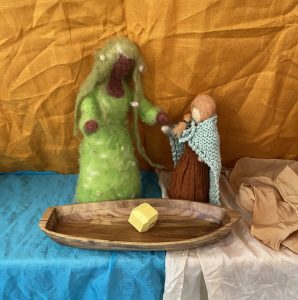 flexible enough to serve as carriers of, or doorways into, complex spiritual concepts and feelings that words alone cannot adequately articulate. For me as a teacher this purpose of the stories is a work forever in progress, with each year building upon the successes of the last. I never forget these moments when the effort bears fruit, when the children show me what the stories might mean. It’s difficult to explain what I’m doing as a preschool teacher working towards ordination at an interfaith seminary, but this week’s castle-in-the-star moment has led me into my fullest answer so far. I feel like I’m just becoming aware of the possibilities of storytelling in early childhood education.
flexible enough to serve as carriers of, or doorways into, complex spiritual concepts and feelings that words alone cannot adequately articulate. For me as a teacher this purpose of the stories is a work forever in progress, with each year building upon the successes of the last. I never forget these moments when the effort bears fruit, when the children show me what the stories might mean. It’s difficult to explain what I’m doing as a preschool teacher working towards ordination at an interfaith seminary, but this week’s castle-in-the-star moment has led me into my fullest answer so far. I feel like I’m just becoming aware of the possibilities of storytelling in early childhood education.
On Thursday at the breakfast table, I taught a song that I made up a couple of years ago for calling down the rain in late summer. I talked about how when the rain comes, it will wash the smoke out of the air– then I offered the song. It’s very simple, with hand and arm movements. The children wanted to sing it over and over and over, so we did. And the next day, we got our rain! I’ll include it here, because a few people were interested in singing it at home as well:
(The movements for the rain song: drum the beat with hands on table or floor (or hand drum) for five beats as you sing: “Rain rain ra-in, come” Then when you sing “down rain,” raise your arms to the sky and look up in a dramatic asking gesture, like a toddler asking to be picked up. Repeat the same for the second time through, but this time as you hold the word “rain” on the longer, louder, higher note, glide your hands down to the table or ground while lightly wiggling your fingers to imitate rain.)
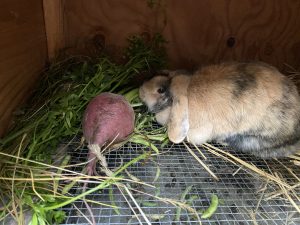 Over the weekend a new animal has joined Bower Tree: a rabbit named Nutmeg, who we’ll be fostering until the spring. She’s an easygoing two-year-old lop and she lives on a melon farm in Washington. Her farm parents (one of whom I befriended a couple of years ago) have lots of other animals and plants to take care of, and Nutmeg loves to be around children, so they thought she’d like to spend the winter in a place where she’ll get more handling and attention. I’m excited to introduce her to the children on Monday. She’s in a hutch behind the climbing structure right now, and we’re working on making her an enclosure under the structure that will connect to the hutch, complete with a door so that children can visit with her, hold her, and feed her fresh greens.
Over the weekend a new animal has joined Bower Tree: a rabbit named Nutmeg, who we’ll be fostering until the spring. She’s an easygoing two-year-old lop and she lives on a melon farm in Washington. Her farm parents (one of whom I befriended a couple of years ago) have lots of other animals and plants to take care of, and Nutmeg loves to be around children, so they thought she’d like to spend the winter in a place where she’ll get more handling and attention. I’m excited to introduce her to the children on Monday. She’s in a hutch behind the climbing structure right now, and we’re working on making her an enclosure under the structure that will connect to the hutch, complete with a door so that children can visit with her, hold her, and feed her fresh greens.
I hope that you’re having a restful weekend, and I hope to see you for acorn gathering tomorrow at noon at the Fernhill Park playground! Bring a bag!
P.S. I added lots of commentary to the photos this week, so please click on the ones that interest you 🙂
Videos
color mixing with an eyedropper
peeling and chopping sweet potato
wednesday morning work and play
julian offering tea to a friend
Photo Gallery

